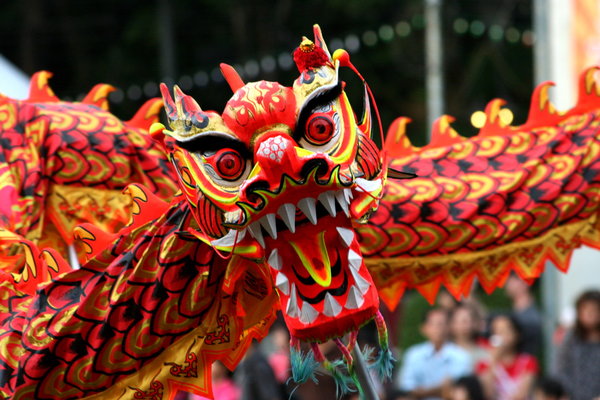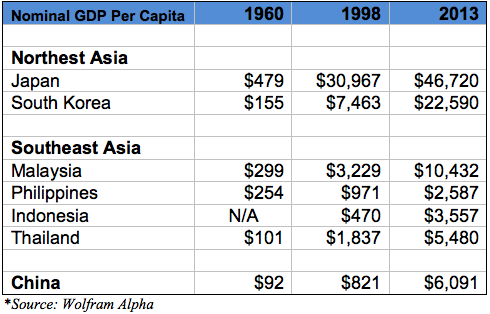Today, one can’t turn on CNBC or Bloomberg without being slapped in the face with the latest episode of Japan’s Abenomics or China’s Great Leap to a Consumption Economy. No doubt, how these two Asian giants manage their economies will determine the fate for many countries in 2014 and beyond.
To get a better grasp of where these economies are headed, it’s probably worth taking a step back and seeing how each got to where it is today. One indispensable book on this subject that I finished reading this week is Joe Studwell’s How Asia Works: Success and Failure in the World’s Most Dynamic Region.
You know how raisin cookies sometimes look like chocolate chip cookies? Then you eat the raisin cookie expecting chocolate but ultimately feel deceived? Well, this book is most certainly not a raisin cookie. As the title suggests, Studwell meticulously lays out the post-World War II stages of economic development for Northeast Asia (Japan, South Korea and Taiwan), Southeast Asia (Thailand, Malaysia, Indonesia and the Philippines) and China. As primarily financial centers with few natural resources and non-descript agricultural histories, Studwell left Hong Kong and Singapore out of the mix. More painfully, the author left out analysis of my parent’s own country and the place I called home for the last five years – Vietnam; he acknowledges this omission, though, so I am not too upset about it.
EASY AS 1,2,3…
According to the author, Asian economic development (1945-2000) goes through three distinct phases: 1) Agricultural and land reform focused on “garden-sized” plots; 2) manufacturing defined by state-guided industrial policy; and 3) financial reforms.
North vs. South
Post WW-II, land reform in Northeast Asia was pursued to equitably spread real estate among the population in the form of “garden-sized” plots. Compared to centralized large-scale plantations, Studwell claims that the “garden-sized” approach was superior on two fronts. First, it solved the post-war issue of mass employment by putting as many people to work as possible. Second, crop yields were higher as more hands were put to use in this labor-intensive sector. Mass employment and higher crop yield had the trickle-down effect of providing adequate food for the population and increased wealth from the crop surplus. The surplus supported exports and boosted each country’s balance of trade as Taiwan, Korea and Japan depended less on food imports.
Building from agricultural strength, these countries pursued manufacturing more aggressively with chaebols of Korea (eg. Hyundai, Samsung) and zaibatzus of Japan (eg. Sony, Mitsui) leading the way. While these conglomerates received massive state subsidies and operated in protected industries, both the Korean and Japanese governments set the stage for innovation by fostering in-country competition and export discipline targeting productive sectors (eg. steel, autos). These conglomerates would be protected as infants but had to eventually make their own way against international competition. For every Hyundai that succeeded globally, there was a Daewoo that crashed and burned.
Finally, financial reforms – namely interest rates, capital controls, foreign investment and exchange rate policies – were used to support agriculture and industry. Whether this meant transferring wealth from households to industry through low interest rates or boosting exports through artificially low exchange rates, financial policies through the 60s, 70s and 80s supported Japanese, Korean and Taiwanese development at the expense of “free markets”. By controlling the financing spigot, these governments diverted cash to large projects and heavy industries that required long-term investments in lieu of quarterly earnings. The efficacy of financial reforms met its limits in each country, though, as the seeds that sowed financial growth also sowed imbalances.
… Or not
In contrast to the development track that Northeast Asia took, the Southeast Asian nations Studwell follows whiffed at each stage of development. In the Philippines, which came out of World War II as the second richest nation in Asia, land reform was concentrated towards large-centralized plantations known as haciendas. Instead of mass employment and crop surplus for staples such as rice, these haciendas produced cash crops (eg. sugar) that saw money flow into very few hands. This framework set the stage for the orgy of kleptocracy under Ferdinand Marcos which plagues the Philippines to this day.
In terms of manufacturing, the Southeast Asian nations did not force export discipline onto its entrepreneurs. To take Malaysia as an example, the government failed to prioritize investments in heavy industry. Instead, entrepreneurs such as Lim Goh Tong were able to make his billions from unproductive but high-margin businesses such as real estate and gambling. While Malaysia ventured into auto making, its lack of export discipline is reflected in the fact that few in the West have ever heard of (let alone ever bought) a Proton – the national carmaker.
Not coming to a dealer near you…
Southeast Asia’s record of financial reform is…shaky to put it lightly. I don’t need to go over all the mistakes that were made in the run-up to 1997 financial crisis. Of the Northeast Asian countries, South Korea was the most roped into the crisis but Malaysia, Indonesia and Thailand were the main victims.
Which Takes Us to China
When Deng Xiaoping became China’s “paramount leader” in 1978, he soon spearheaded land reform that encouraged “garden-sized” agriculture, which stood in stark contrast to the large collectivized agriculture under Mao Zedong. As in Japan, Korea and Taiwan before it, China's household farming initiative provided employment and food for the masses. Surpluses supported a burgeoning countryside market place and laid the groundwork for one of the most rapid periods of industrialization (1978-2008) the world has ever seen.
In the place of chaebols and zaibatsus, China nurtured massive state-owned enterprises in oligopolistic settings. Whether in banking (Industrial and Commercial Bank of China, Agricultural Bank of China, Bank of China and China Construction Bank), oil & gas (eg, Sinopec, CNOOC, PetroChina), network equipment (Huawei, ZTE) or telecoms (Chinese Mobile, Chinese Telecom), the Chinese government set economic and trade policies that protected their own while also forcing gradual global integration. By keeping wages low, interests rates low and foreign exchange low, China orchestrated a massive transfer of wealth from the households into industry, which has driven this export-investment growth machine since.
The first two steps in Asian development – agricultural/land reform and manufacturing reform – have produced clear winners (Northeast Asia) and losers (Southeast Asia). China has followed in the track of the winners. It is the third aspect – financial reform – that has tripped up every country. Clearly, financial reform is only one part of the equation. But with China’s large shadow banking sector and seemingly never-ending credit growth, it is a big part. Studwell gives kudos to China’s performance over the past three decades but is not ready to crown them champions. In addition to financial reforms, he adds the challenges of income inequality, an unfavorable demographic shift, democratic reform, institutional deficiencies and social unrest born from slowing growth.
Japan was in practically the same shoes 25 years ago. The island nation’s financial reforms in the 80s, which supported an export-investment directed industry, ultimately lead to a massive asset bubble and crash. Abenomics and the three arrows for reflation and growth are only the latest effort to turn back the tide that crashed onto Japan two decades ago.
With Japan's economic performance shows, there is no sure-fire blueprint from Asia’s recent economic history to suggest China can manage this situation. Xi Jinping and the new leadership will be under great pressure to show it can. With the world watching, China should be able to keep the façade going through 2014; but clearly, cracks are showing. Having said that, if the country powers through and completes the the trifecta of reforms, it deserves a cookie. A chocolate chip cookie.

























Hello Trung. Interesting and entertaining summary of the book. I too am disappointed there is nothing written about Vietnam. I am also living here since moving from the US two years ago. I was born here also.